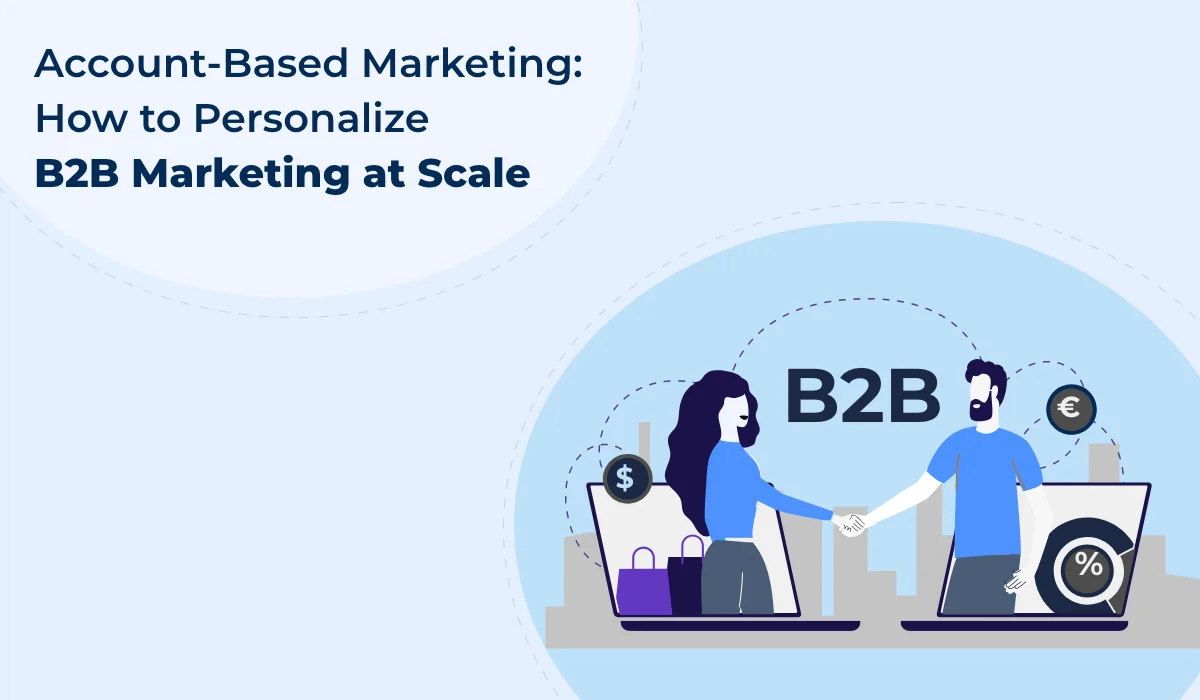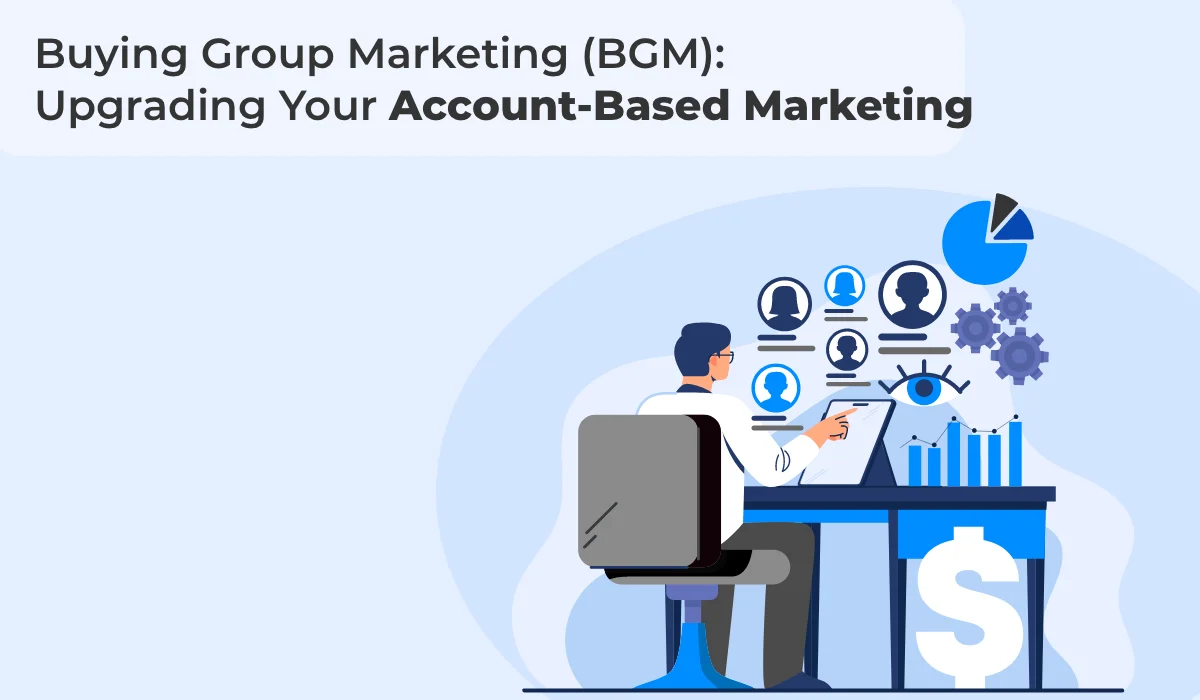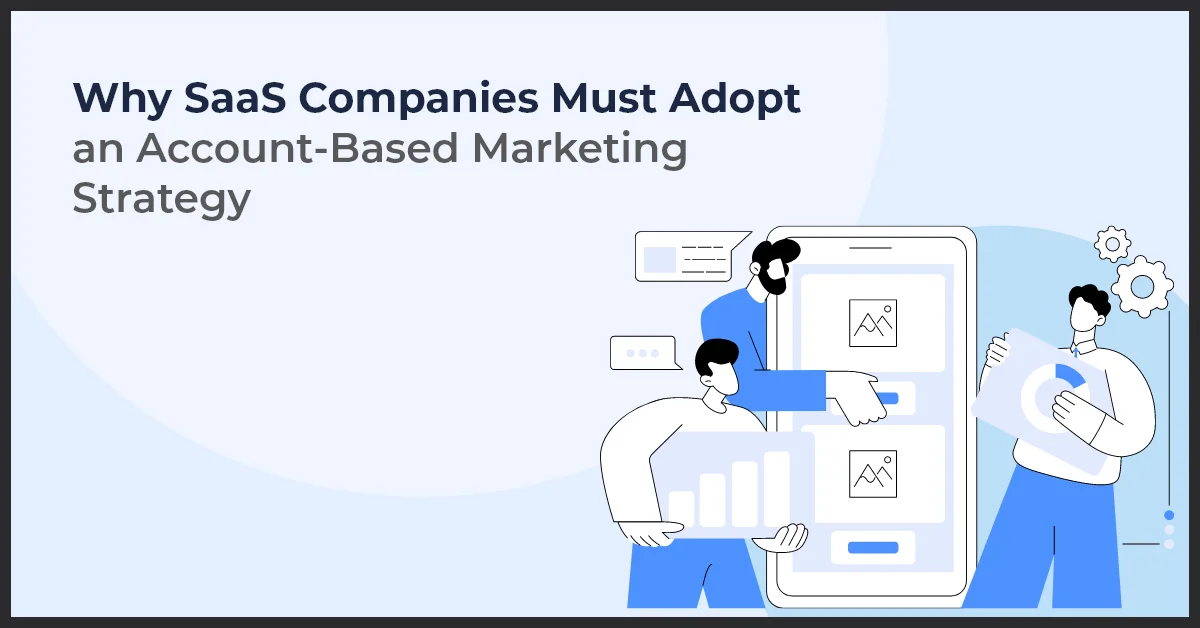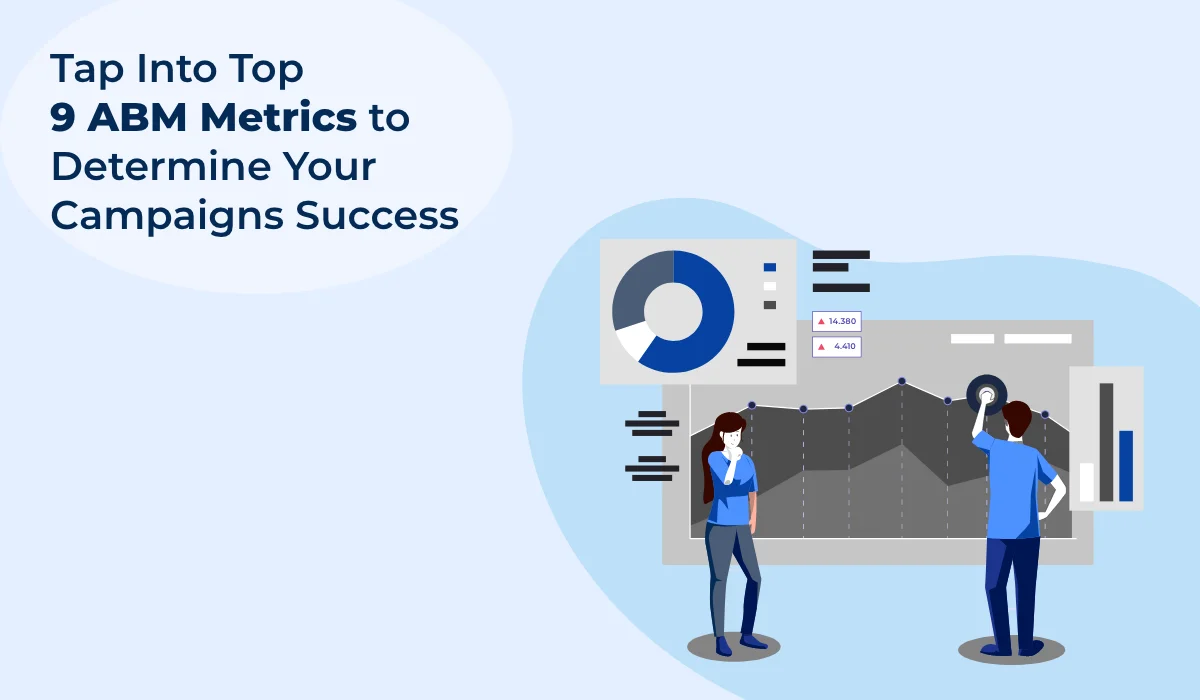Account-Based Marketing: How to Personalize B2B Marketing at Scale

Published on: April 26, 2023
Updated on: June 25, 2024
879 Views
- Account Based Marketing
14 min read
Are you tired of sending out generic marketing messages to your whole email list and not getting any meaningful engagement? Worse yet, are you not seeing any conversions in your B2B sales pipeline? Then, you are not alone.
Marketers are looking for innovative methods to stand out and get tangible results as the B2B marketing landscape becomes more clogged and saturated. They need a strategy that can help the succeed in this cut-throat competition. And Account-Based Marketing (ABM) is the best solution.
ABM has been gaining traction among B2B marketers due to its ability to target high-value clients with individualized, relevant communications.
ABM is fundamentally about identifying the relevant accounts and developing focused campaigns that address their specific demands and pain areas. In this article, we are going to discuss everything you need to know about ABM.
Let’s dive in!
Navigating the Pros and Cons of Account-Based Marketing in B2B
Benefits of Account-Based Marketing
Higher ROI
Account-based marketing enables companies to hone their efforts on high-value clients with the potential to generate a sizable income. Businesses have a higher chance of turning leads into customers by focusing on specific accounts and developing targeted marketing strategies for them, which eventually produces a higher return on investment (ROI).
Increased Customer Retention
By providing more tailored experiences, ABM helps businesses strengthen ties with current customers. When a company focuses on a client's unique requirements and pain spots, they are more likely to keep that customer and establish loyalty.
Personalized Marketing Experiences
Account-based marketing enables more focused and personalized marketing experiences. Businesses may design a more successful campaign that appeals directly to the particular pain points of each account by personalizing messages to their specific requirements.
Marketo is a marketing automation software that targeted their top 100 accounts using ABM. To reach decision-makers, they built bespoke campaigns for each account and deployed targeted advertising. As a result, the pipeline increased by 55% and the potential value increased by 130%.
Challenges of Account-Based Marketing
Higher Costs
One of the most significant issues of ABM is the greater expense of the strategy. ABM necessitates a significant commitment of resources, such as time, money, and employees. Businesses must carefully assess the expenses of deploying ABM against the possible ROI.
Longer Sales Cycles
Because ABM focuses on high-value clients, it might result in lengthier sales cycles. Building connections and trust with these accounts takes time, which can hold down the sales process. When employing ABM, businesses must be prepared for lengthier sales cycles.
Greater Collaboration Required
ABM necessitates strong collaboration between marketing and sales departments to maintain alignment and improve campaign performance. Businesses must ensure that their teams are aligned and efficiently working together to achieve their ABM objectives.
Also see:
- Account Based Marketing (ABM) Vs Traditional Lead Generation – Key Differences
- 6 Step Strategy For Successful Account Based Marketing Campaign
Best Practices for Implementing Account-Based Marketing
Build an ABM Strategy
The first step in implementing ABM is to create a strategy that is in line with your company's objectives. This entails identifying the main accounts to target and developing a strategy to engage them through tailored marketing campaigns.
Consider the following while developing an effective ABM strategy:
Establish your Target Accounts
Begin by determining the most critical accounts for your company. These might be huge corporate firms, strategic partners, or high-growth opportunities.
Understand your Target Accounts
Once you've identified your target accounts, conduct research and analysis to learn about their needs, pain areas, and purchasing habits. This data will assist you in developing tailored campaigns that are appealing to your target audience.
Define your Objectives and Key Performance Indicators (KPIs)
Determine what success looks like for your ABM program and define quantifiable goals and KPIs. This allows you to track progress and improve your campaigns over time.
Determine Target Accounts
Once you've identified your target accounts, the following step is to pinpoint the persons inside those accounts who are most likely to be decision-makers or influencers in the purchasing process.
Consider the following when identifying target accounts:
Make Use of Data and Analytics
Use data and analytics to find accounts that match your ideal customer profile (ICP). Look for accounts that have qualities comparable to your current consumers and are likely to have a demand for your product or service.
Participate with Essential Stakeholders
Build connections with important stakeholders inside your target accounts, such as executives or decision-makers, to acquire insights into their requirements and goals.
Make Customized Content
Once you've identified your key stakeholders and target accounts, it's essential to produce tailored content that speaks directly to their needs and interests. Customized messaging, case studies, whitepapers, and other information that showcases your expertise and value offer are examples of this.
Consider the following while creating tailored content:
Leverage Account Insights
Use the information gleaned through research and interaction to create content that speaks directly to your target accounts. This may entail adjusting your messaging or content type to each account's specific demands.
Collaborate with Sales
Collaborate with your sales team to ensure that your messaging is consistent and that your material is targeted to the individual requirements and interests of each customer.
Measure Success
Measuring your ABM program's success is crucial to its long-term success. Tracking and evaluating critical indicators such as engagement rates, conversion rates, and pipeline velocity are all part of this.
Consider the following indicators of success:
- Determine the primary metrics you will use to monitor the performance of your ABM program and establish reasonable objectives for each.
- Use data and analytics tools to track and evaluate critical indicators, and make data-driven decisions to enhance your campaigns over time.
Addressing Key Factors in Choosing an ABM Strategy
Target Market
The size of your target market is a critical consideration when selecting an ABM approach. Businesses with smaller target markets—typically 10 to 500 clients—find ABM to be very beneficial. Companies can improve their target marketing and sales efforts by focusing on targeted clients. Thus, this will increase the likelihood that leads will become customers.
Personalization
Another critical thing to consider when selecting an ABM approach is the amount of personalization necessary. The capacity to generate individualized experiences for each account is critical to the success of ABM. This means that organizations must have access to high-quality data to obtain insights into the requirements, interests, and habits of each account. They must also have the tools to develop customized content, such as personalized emails, landing sites, and other marketing assets.
How to Execute Successful ABM Campaigns: Tips and Best Practices
Effective Communication Between Sales and Marketing Teams
ABM campaign success is strongly reliant on the collaboration and alignment of sales and marketing teams. Encourage regular meetings and open lines of communication to ensure that both teams are on the same page and working toward the same objectives.
Use Data and Analytics
Data and analytics are critical components of ABM campaigns. Identify the most successful channels, messages, and approaches for interacting with your target accounts using data. Use analytics to track the effectiveness of your efforts and make data-driven optimization decisions.
Personalize Your Content
One of the most important aspects of ABM is personalization. Create customized content that speaks to your target accounts' individual pain areas and requirements. Personalized content increases not simply engagement but also trust and credibility with your target accounts.
Test and Optimize
ABM programs must be tested and optimized continuously to guarantee that they are achieving the expected outcomes. To increase marketing performance and ROI, test and refine campaigns continuously using data and analytics.
Tools and Strategies for Successful Account-Based Marketing
There are several ABM solutions and technologies on the market that may assist firms in executing efficient ABM campaigns. Here are a few of the most popular:
- Marketo is a marketing automation software with ABM capabilities such as account-based advertising, account scoring, and tailored content.
- HubSpot is a marketing and sales platform that offers ABM capabilities including account-based advertising, lead nurturing, and tailored content.
- Salesforce Marketing Cloud is a complete marketing automation platform with capabilities such as account-based advertising, lead nurturing, and account scoring.
- Pardot is a B2B marketing automation software with capabilities including account-based advertising, lead nurturing, and account scoring.
Comparison of ABM Solutions
| ABM Solution | Features | Pros | Cons | Price |
|---|---|---|---|---|
| Marketo |
Account-based advertising Account scoring Tailored content |
Robust ABM functionality Integration with other marketing automation tools |
Higher cost compared to other solutions | Starting at $895/month |
| HubSpot |
Account-based advertising Lead nurturing Tailored content |
User-friendly interface All-in-one marketing and sales platform |
Limited ABM features compared to other solutions | Starting at $800/month |
| Salesforce Marketing Cloud |
Account-based advertising Lead nurturing Account scoring |
Comprehensive marketing automation platform Integration with Salesforce CRM |
Higher cost compared to other solutions | Starting at $4,000/month |
| Pardot |
Account-based advertising Lead nurturing Account scoring |
Robust ABM functionality Integration with Salesforce CRM |
Higher cost compared to other solutions | Starting at $1,250/month |
Comparison of ABM Strategies
One-to-One ABM
Companies with a narrow target market and high-value products or services will find this strategy most effective. Marketers may deliver a personalized experience by focusing all of their efforts on a single account, taking into consideration the unique challenges and pain points of the account. This increases conversion rates and strengthens the relationship between the business and the account.
One-to-Few ABM
Companies with a medium-sized target market and high-value goods or services are best suited for this strategy. The breadth of accounts targeted distinguishes one-to-one ABM from one-to-few ABM. Marketers may still provide a personalized experience that answers the unique demands and difficulties of each account by focusing on a small number of accounts rather than just one.
Many-to-many ABM
Many-to-many ABM targets a bigger set of accounts using a less focused marketing strategy. This approach works well for companies that have a large target market and provide low-quality goods or services. Many-to-many ABM places more of an emphasis on developing broad, scalable campaigns that are nonetheless pertinent to the target audience than on tailoring the marketing strategy for each account. For companies that need to reach a large number of accounts, this strategy may be more affordable and simpler to scale than other types of ABM.
Tips for Choosing the Right ABM Tools and Strategies
Evaluate the Level of Personalization Required
The amount of personalization necessary in your ABM campaigns will be determined by your target accounts' demands. One-to-one campaigns may be more suited for high-value accounts, whilst a one-to-many strategy may be better suited for accounts with comparable qualities.
Assess the Capabilities of Your Team
When selecting ABM tools and methods, keep your team's talents and expertise in mind. If your staff has little experience with ABM, choosing solutions that provide training and assistance will help them come up to speed fast.
Consider the Integration with Other Marketing Tools
ABM technologies that can interact with other marketing tools and platforms, such as your CRM and marketing automation software, are essential. This will guarantee that your marketing and sales strategies are consistent and that you can readily assess the performance of your initiatives.
Stay Up-To-Date with New Tools and Trends
ABM is a discipline that is continually growing, with new tools and trends appearing all the time. It is critical to remain current with these advances and to analyze your ABM strategy regularly to ensure that you are employing the most effective tools and methods for your organization.
Examples of Successful Account-Based Marketing Campaigns
Terminus
Terminus is a B2B marketing software startup that offers organizations account-based marketing solutions. They targeted a high-value account with a customized video that emphasized the benefits of their product for that specific account in one of their ABM campaigns. The video was customized to the account's industry and issues, and it featured a call to action to set up a sample. Terminus earned more than $50,000 from this campaign.
The customized approach and usage of video, which is a very engaging medium, contributed to the success of this campaign. Terminus was able to attract their attention and develop an interest in their solution by personalizing their message to the unique demands of the customer.
Demandbase
Demandbase is an ABM software startup that assists organizations in identifying and engaging high-value clients. They targeted a set of high-value accounts with a customized online experience in one of their ABM efforts. The website was customized to each account's requirements and interests, including personalized content, messaging, and calls to action. This campaign increased interaction with their target accounts by 450% and resulted in numerous new client acquisitions.
The implementation of a tailored website experience, which allowed Demandbase to offer highly targeted and relevant material to their target accounts, was what made this campaign effective. They were able to attract their attention and develop an interest in their solution by adapting their website to the individual demands and interests of each customer.
The Future of Account-Based Marketing
Account-based marketing has both challenges and opportunities for organizations in the future. On the one hand, as firms attempt to create deeper connections with key clients and drive revenue growth, ABM is going to become increasingly more significant. As ABM becomes more popular and the number of target accounts expands, organizations will need to discover methods to balance personalization with scalability.
Navigating data privacy legislation will be one of the most difficult tasks for ABM in the future, especially when new laws are established throughout the world. This will necessitate businesses being even more cautious in their collection and use of consumer data, as well as finding new ways to communicate with target customers without invading their privacy.
Another difficulty for ABM will be dealing with rising competition as more organizations use ABM to reach their target clients. Businesses will need to be even more strategic in their approach, as well as discover methods to separate themselves from their competition.
Latest Trends in Account-Based Marketing
Artificial Intelligence (AI) and Machine Learning (ML)
AI and machine learning are changing the way firms handle ABM. These tools can analyze enormous data sets to detect trends and forecast customer behavior, allowing marketers to focus their efforts more effectively.
Predictive Analytics
Another area where ABM is making great strides is predictive analytics. Marketers may focus their efforts on the accounts that are most likely to convert by utilizing data to anticipate which accounts are most likely to convert.
Balancing Personalization and Scalability
One of the most difficult difficulties for ABM is balancing personalization and scalability. While targeted advertising is more successful, scaling them can be tough. Marketers must devise methods to customize marketing while maintaining scalability.
Impact of Data Privacy Regulations
As data privacy standards become more severe, marketers will need to discover new strategies to target their efforts while remaining compliant. This might imply utilizing less personal data and developing new ways to reach target accounts.
Increased Competitiveness
As more organizations use ABM techniques, competition will heat up. Marketers will need to discover new methods to distinguish themselves from their competition.
ABM can provide enormous benefits to enterprises in terms of opportunity. Businesses may increase revenue and enhance ROI by focusing their efforts on high-value accounts. Furthermore, ABM may increase communication between sales and marketing teams, resulting in more successful campaigns.
Conclusion
Account-based marketing is an effective method for B2B companies wanting to boost their ROI by focusing on high-value clients. ABM may help firms achieve greater success in their marketing and sales activities by concentrating on individualized communication and interaction with key decision-makers.
Businesses must carefully examine elements such as target market size, personalization degree, and available resources when using ABM. They should also select the correct tools and techniques that are aligned with their company goals, scalable, and simple to use. Looking ahead, emerging developments like AI and machine learning are likely to impact the future of ABM, and firms must be prepared to combine customization with scalability while also complying with data protection requirements to remain competitive.
Our team of seasoned professionals will work with you to create a customized ABM strategy that delivers results you can see and measure. Contact us today at info@growthnatives.com or call +1 855-693-4769 to get started and experience the power of ABM done right.
Frequently Asked Questions
The ABM approach to marketing focuses on identifying and targeting high-value accounts with personalized campaigns, aligning sales and marketing efforts, and delivering tailored content to drive engagement, build relationships, and increase conversions.
Personalization is crucial in ABM because it helps build stronger relationships with target accounts, increases engagement by addressing specific pain points and needs, and improves the chances of converting leads into customers by providing relevant and tailored content.
Identify target accounts by analyzing factors such as company size, industry, revenue, potential for growth, alignment with your product or service, and engagement history. Use data and insights from CRM systems, market research, and sales teams to select high-value accounts.
Effective personalization tactics include creating customized content and messaging, tailoring website experiences, personalizing email campaigns, using targeted ads, developing account-specific landing pages, and leveraging personalized direct mail and gifts.
Technology can help scale ABM personalization efforts through marketing automation platforms, CRM systems, AI and machine learning tools, personalization software, account intelligence tools, and data analytics solutions.
Create an ABM strategy by defining your goals and objectives, identifying and prioritizing target accounts, developing personalized content and campaigns, aligning sales and marketing efforts, implementing the necessary tools and technologies, and continuously measuring and optimizing your approach.
Data plays a critical role in ABM by providing insights into target accounts, enabling personalization, tracking engagement and performance, identifying opportunities for optimization, and supporting decision-making throughout the ABM process.
Future trends in ABM include increased use of AI and machine learning for predictive analytics and personalization, greater integration of ABM with other marketing and sales technologies, more emphasis on customer experience and journey mapping, and continued focus on data-driven decision-making and measurement.



